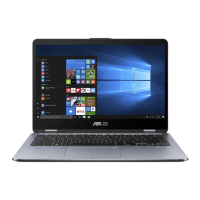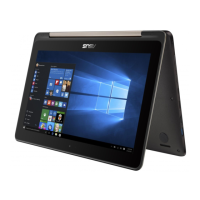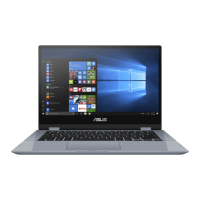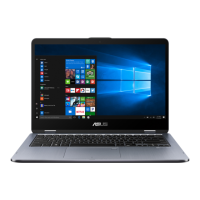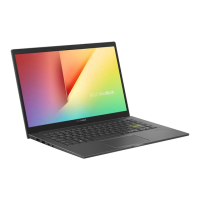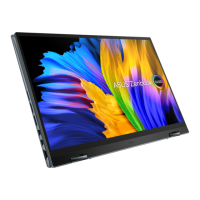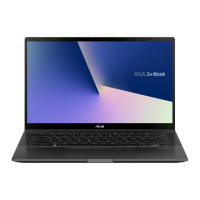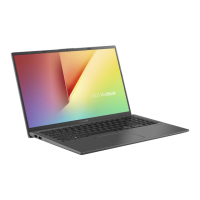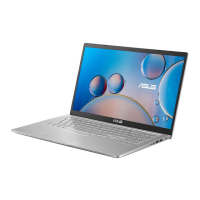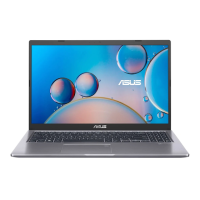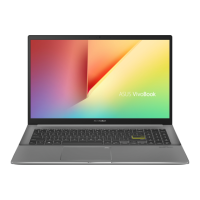Do you have a question about the Asus VivoBook Flip 14 and is the answer not in the manual?
Explains icons, typography, and important notes used in the manual.
Safety tips for operating the Notebook PC in different environments.
Instructions for cleaning and maintaining the Notebook PC.
Guidance on the correct disposal of the Notebook PC and battery.
Introduction to the Notebook PC's physical components.
Identification of components on the top side of the Notebook PC.
Details of components and features on the bottom of the Notebook PC.
Overview of ports and connectors on the right side.
Overview of ports and features on the left side.
Initial steps for setting up and using the Notebook PC.
Instructions for charging the Notebook PC's battery.
How to open the Notebook PC's display panel.
Instructions for using the power button.
Explains touch screen and touchpad gestures for navigation.
Detailed guide to touch screen gestures for navigation.
How to use the touchpad for navigation and interaction.
Steps to set up fingerprint login for enhanced security.
Information on using the keyboard and special keys.
Explains the functions of the F1-F12 keys.
Details on special Windows keys on the keyboard.
How to adjust the display panel for different modes.
Guide to initial Windows 10 setup and configuration.
Overview of the Start menu as a gateway to apps, settings, and features.
Information on pinned apps in tiled format for quick access.
Instructions for launching, customizing, and closing apps.
Steps to move, resize, unpin, or pin apps to the taskbar.
How to switch between apps and desktops using the task view feature.
Displays apps side-by-side for multitasking and switching.
Using drag-and-drop to snap apps into place on the screen.
Consolidates notifications and quick actions for interaction.
Useful keyboard shortcuts for launching apps and navigating Windows 10.
Steps to connect to Wi-Fi and Bluetooth networks.
Guide to connecting your Notebook PC to a Wi-Fi network.
Instructions for pairing and connecting Bluetooth-enabled devices.
How to enable or disable Airplane mode for wireless communication.
Procedures for safely shutting down the Notebook PC.
Steps to put the Notebook PC into Sleep mode.
Explanation of diagnostic tests run during startup.
Accessing BIOS settings or troubleshooting options via POST.
Overview of BIOS and its role in system startup.
Methods to enter the BIOS settings.
Information on navigating and understanding BIOS setup screens.
Introduction to the EZ Mode BIOS interface.
Setting boot option priorities for the system.
Setting up administrator and user passwords for system access.
Procedures for saving configuration and exiting BIOS.
Step-by-step guide to updating the Notebook PC's BIOS.
Recommendations for maximizing performance and securing data.
Answers to common questions about Notebook PC hardware.
Solutions to frequently asked questions regarding software issues.
Details about the DVD-ROM drive's functionality.
Information on the Blu-ray ROM drive capabilities.
Information on the internal modem's compliance standards.
General overview of CTR 21 regulations.
Statement regarding network compatibility of the equipment.
Eligibility criteria for non-voice equipment.
FCC compliance statement regarding radio frequency interference.
Cautionary statement regarding FCC RF exposure limits.
Information on Specific Absorption Rate (SAR) compliance.
Canadian compliance statement for IC radiation exposure.
Safety precautions related to UL standards for electrical devices.
Requirements for power cords used with certain products.
Notices for CATV system installers regarding grounding.
Information on REACH compliance for chemical substances.
Notice regarding copyright protection technology.
Advice on preventing hearing damage from loud volumes.
Safety warnings for handling lithium-ion batteries.
Approval details for CTR 21 standard for modems.
Information on ENERGY STAR compliance and power management.
ASUS's commitment to environmental regulations and disclosures.
Information on ASUS's recycling and takeback programs.
Contact information for battery recycling services.
Notice regarding protective coating on the device.
Warning regarding cancer and reproductive harm.
Compliance notice for IMDA Standards in Singapore.
Compliance with India E-Waste Management Rules.
Safety notices concerning removable batteries.
Compliance with NTC Standards in the Philippines.
Declaration of conformity with EU directives.
Table showing RF output power for various functions.
Explains icons, typography, and important notes used in the manual.
Safety tips for operating the Notebook PC in different environments.
Instructions for cleaning and maintaining the Notebook PC.
Guidance on the correct disposal of the Notebook PC and battery.
Introduction to the Notebook PC's physical components.
Identification of components on the top side of the Notebook PC.
Details of components and features on the bottom of the Notebook PC.
Overview of ports and connectors on the right side.
Overview of ports and features on the left side.
Initial steps for setting up and using the Notebook PC.
Instructions for charging the Notebook PC's battery.
How to open the Notebook PC's display panel.
Instructions for using the power button.
Explains touch screen and touchpad gestures for navigation.
Detailed guide to touch screen gestures for navigation.
How to use the touchpad for navigation and interaction.
Steps to set up fingerprint login for enhanced security.
Information on using the keyboard and special keys.
Explains the functions of the F1-F12 keys.
Details on special Windows keys on the keyboard.
How to adjust the display panel for different modes.
Guide to initial Windows 10 setup and configuration.
Overview of the Start menu as a gateway to apps, settings, and features.
Information on pinned apps in tiled format for quick access.
Instructions for launching, customizing, and closing apps.
Steps to move, resize, unpin, or pin apps to the taskbar.
How to switch between apps and desktops using the task view feature.
Displays apps side-by-side for multitasking and switching.
Using drag-and-drop to snap apps into place on the screen.
Consolidates notifications and quick actions for interaction.
Useful keyboard shortcuts for launching apps and navigating Windows 10.
Steps to connect to Wi-Fi and Bluetooth networks.
Guide to connecting your Notebook PC to a Wi-Fi network.
Instructions for pairing and connecting Bluetooth-enabled devices.
How to enable or disable Airplane mode for wireless communication.
Procedures for safely shutting down the Notebook PC.
Steps to put the Notebook PC into Sleep mode.
Explanation of diagnostic tests run during startup.
Accessing BIOS settings or troubleshooting options via POST.
Overview of BIOS and its role in system startup.
Methods to enter the BIOS settings.
Information on navigating and understanding BIOS setup screens.
Introduction to the EZ Mode BIOS interface.
Setting boot option priorities for the system.
Setting up administrator and user passwords for system access.
Procedures for saving configuration and exiting BIOS.
Step-by-step guide to updating the Notebook PC's BIOS.
Recommendations for maximizing performance and securing data.
Answers to common questions about Notebook PC hardware.
Solutions to frequently asked questions regarding software issues.
Details about the DVD-ROM drive's functionality.
Information on the Blu-ray ROM drive capabilities.
Information on the internal modem's compliance standards.
General overview of CTR 21 regulations.
Statement regarding network compatibility of the equipment.
Eligibility criteria for non-voice equipment.
FCC compliance statement regarding radio frequency interference.
Cautionary statement regarding FCC RF exposure limits.
Information on Specific Absorption Rate (SAR) compliance.
Canadian compliance statement for IC radiation exposure.
Safety precautions related to UL standards for electrical devices.
Requirements for power cords used with certain products.
Notices for CATV system installers regarding grounding.
Information on REACH compliance for chemical substances.
Notice regarding copyright protection technology.
Advice on preventing hearing damage from loud volumes.
Safety warnings for handling lithium-ion batteries.
Approval details for CTR 21 standard for modems.
Information on ENERGY STAR compliance and power management.
ASUS's commitment to environmental regulations and disclosures.
Information on ASUS's recycling and takeback programs.
Contact information for battery recycling services.
Notice regarding protective coating on the device.
Warning regarding cancer and reproductive harm.
Compliance notice for IMDA Standards in Singapore.
Compliance with India E-Waste Management Rules.
Safety notices concerning removable batteries.
Compliance with NTC Standards in the Philippines.
Declaration of conformity with EU directives.
Table showing RF output power for various functions.
| Form factor | Convertible (Folder) |
|---|---|
| Product type | Hybrid (2-in-1) |
| Product color | Gray |
| Bus type | OPI |
| Stepping | D1 |
| Tjunction | 100 °C |
| Processor cache | 4 MB |
| Processor cores | 2 |
| Processor model | i7-6500U |
| System bus rate | 4 GT/s |
| Processor family | Intel® Core™ i7 |
| Processor series | Intel Core i7-6500 Mobile series |
| Processor socket | LGA 1356 (Socket B2) |
| Processor threads | 4 |
| Processor codename | Skylake |
| Configurable TDP-up | 25 W |
| Processor frequency | 2.5 GHz |
| Processor cache type | Smart Cache |
| Configurable TDP-down | 7.5 W |
| Processor lithography | 14 nm |
| Processor manufacturer | Intel |
| Processor front side bus | - MHz |
| PCI Express slots version | 3.0 |
| Processor boost frequency | 3.1 GHz |
| Processor operating modes | 64-bit |
| ECC supported by processor | No |
| PCI Express configurations | 1x4, 4x1 |
| Thermal Design Power (TDP) | 15 W |
| Configurable TDP-up frequency | 2.6 GHz |
| Configurable TDP-down frequency | 0.8 GHz |
| Maximum number of PCI Express lanes | 12 |
| Numeric keypad | Yes |
| Pointing device | Touchpad |
| Memory slots | 1x SO-DIMM |
| Internal memory | 8 GB |
| Memory clock speed | 2133 MHz |
| Memory form factor | On-board + SO-DIMM |
| Internal memory type | DDR4-SDRAM |
| Maximum internal memory | 12 GB |
| Memory layout (slots x size) | 1 x 4 GB |
| HDD speed | 5400 RPM |
| HDD interface | SATA |
| Storage media | HDD |
| Total storage capacity | 1000 GB |
| Compatible memory cards | SD, SDHC |
| Number of HDDs installed | 1 |
| Display surface | Gloss |
| Display diagonal | 15.6 \ |
| Display resolution | 1366 x 768 pixels |
| Native aspect ratio | 16:9 |
| On-board graphics card ID | 1916 |
| Discrete graphics card model | NVIDIA® GeForce® 940MX |
| On-board graphics card model | Intel® HD Graphics 520 |
| Discrete graphics card memory | 2 GB |
| On-board graphics card family | Intel® HD Graphics |
| Maximum on-board graphics card memory | 1.74 GB |
| On-board graphics card OpenGL version | 4.4 |
| On-board graphics card base frequency | 300 MHz |
| On-board graphics card DirectX version | 12.0 |
| On-board graphics card dynamic frequency (max) | 1050 MHz |
| Front camera resolution | 640 x 480 pixels |
| Front camera resolution (numeric) | 0.3 MP |
| Wi-Fi standards | 802.11b, 802.11g, Wi-Fi 4 (802.11n) |
| Bluetooth version | 4.0 |
| Top Wi-Fi standard | Wi-Fi 4 (802.11n) |
| Ethernet LAN data rates | 10, 100, 1000 Mbit/s |
| USB 2.0 ports quantity | USB 2.0 ports have a data transmission speed of 480 Mbps, and are backwards compatible with USB 1.1 ports. You can connect all kinds of peripheral devices to them. |
| VGA (D-Sub) ports quantity | 0 |
| Audio system | SonicMaster |
| Speaker power | 1.6 W |
| Battery capacity | 38 Wh |
| Battery life (max) | 6 h |
| AC adapter power | 65 W |
| AC adapter frequency | 50 - 60 Hz |
| AC adapter input voltage | 100 - 240 V |
| AC adapter output current | 3.42 A |
| AC adapter output voltage | 19 V |
| Processor code | SR2EZ |
| Processor ARK ID | 88194 |
| Processor package size | 42 X 24 mm |
| Supported instruction sets | SSE4.1, SSE4.2, AVX 2.0 |
| Intel Secure Key Technology version | 1.00 |
| Intel Stable Image Platform Program (SIPP) version | 0.00 |
| Depth | 253 mm |
|---|---|
| Width | 377.7 mm |
| Height | 22.5 mm |
| Weight | 2200 g |
